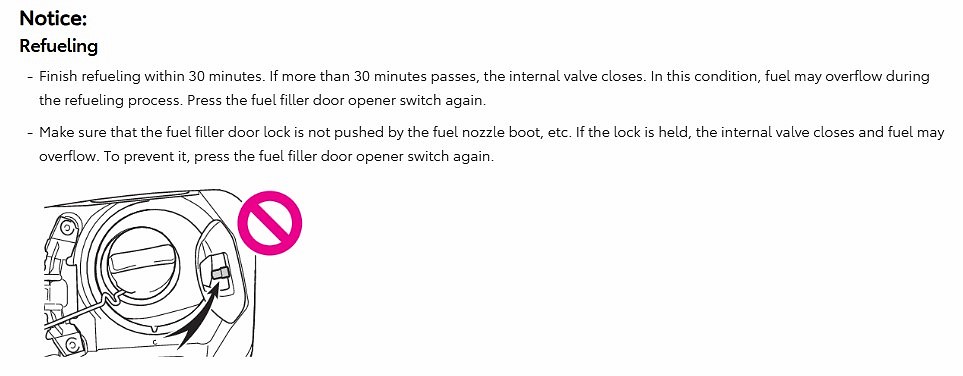It recently occurred to me that we've had my spouse's 2024 Toyota Rav4 Hybrid for one year now, and there are still many things I don't know about it. This thought was prompted by the latest episode of the Car Care Nut YouTube channel comments section, where I stumbled upon this hybrid fuel door idiosyncrasy.

I should have known about this, but old Hot Rod issues from the '70s hold my attention much longer than our Rav4 Hybrid owner's manual.
At least I am not alone:
Having owned my 2024 Sienna for a year now, the C.C.N. videos have been very helpful. I had no clue about the refueling system. While I don't think about opening the fuel door and not refueling, but with 3 kids…things happen. Let's hope I can remember this for the next 12 years of ownership." @get2themetal
Yep. I found out about the fuel refill. Stopped for gas at one station, but the pump wasn't working. I got in to drive to another station (forgot to put the cap back on and close the fuel door), got to the next station, and started filling, then SPLASH! ―@serafinsilva1055
Long story short, the host explains it like this:
"Hybrids have a much higher emission rating because they are hybrids. In order to achieve that high emission rating, they have a kind of very sophisticated evaporative emission system. The purpose is to trap gasoline vapors, as they are harmful to the environment.
So what they'll do is they'll actually switch a valve that isolates the vapor, so when you open this gas cap, you don't have vapor coming out.
How this is something you need to know is that, let's say, you stopped at a gas station, you stopped at the pump, you opened the gas door, and then the kids started screaming: "I need to use the restroom. Let's go! I'm hungry; let's go eat!." You left it open, and you went inside. We had a good meal and had a great time.
Then you came out, and you want to refuel. Well, if half an hour has passed, that valve that opened to allow refueling has waited for 30 minutes, and if nothing happens, it's going to close. And then, when you go fill it as soon as you put the pump nozzle, it'll just overflow and cover you with fuel―that is normal folks."
8 More Quirks You Might Not Know About
Follow along with the host in the video below and discover if any of the eight other idiosyncrasies he discusses have had you scratching your head on occasion. If so, then now, you will finally know what that was all about.
If you'd like to skip ahead to the other eight, a brief summary is provided below the video.
Things You Should Know About Toyota Hybrids! The Most Common Questions
Video Quirk Quick Summary
- Brake pedal feel: A hydraulic braking system and regenerative braking system work together based on sensor "feel" to determine the braking need you have at the moment. Some Toyota Hybrid owners complain of the resulting nosedive effect they experience, and then mistakenly assume something is wrong with the brakes, when in fact, there isn't anything wrong; it's just a two-system "brake feel" we are not used to yet.
- What happens when the Hybrid battery fails? The hybrid system disengages, the car enters a failsafe mode, the dash warning lights come on like a Christmas tree, and the gasoline-powered engine kicks on permanently, avoiding any further use of the hybrid battery. You can still turn the engine off and back on because a residual amount of hybrid electricity remains available to keep you going in non-hybrid mode. However, the going will be rougher, the gas mileage will drop significantly, and you might not be able to move in reverse because the reverse gear is hybrid battery-dependent. Only when the hybrid battery is completely depleted will you be unable to restart the car and thereby cannot run in gas engine mode any further.
- The sounds that Toyota Hybrids make: (1) The whining noise when slowing to a stop is the regenerative braking kicking in―not a failing of the transmission. (2) The buzzing noise as you enter the hybrid is the braking system pumping itself, preparing for the drive.
- What does the "ready" light mean?: The "ready" light is a visual cue to let you know that the car is "on," even though it may sound like it is turned off. If you leave the car while it is in the "ready" light mode, the hybrid will automatically shut off after one hour.
- What is EV mode?: EV mode forces the car to remain in electric mode only. However, you cannot accelerate quickly, and you cannot exceed 25 mph. It used to be a type of electric running quiet mode, but now, with the loud, strange proximity sensor sounding off, that is no longer the case.
- Will rock back and forth when the engine starts: When the engine starts, one of the two electric motors engages to accomplish the start, which then transfers some of that energy across the vehicle, producing a slight rocking motion―this is normal. However, one point about this is that if the hybrid is left in neutral and the parking brake is not engaged, the car may roll forward unexpectedly. Do not leave a hybrid in neutral for 10-15 minutes. However, 5 minutes in neutral during a car wash is okay.
- How to make the hybrid battery last: Toyota hybrid batteries are air-cooled. A fan with a dust-catching filter blows air onto the hybrid battery. If the filter gets clogged by dirt, pet fur, etc., the hybrid battery will get overheated, and damage will occur that will significantly shorten its life. Always check to ensure that the fan filter is clean.
- What does the shifter do?: Mechanically, the shifter only engages the parking prawl. Everything else you do with the shifter is sending a message to the hybrid system what it is that you intend to do: go forward or go reverse (upon lifting your foot off the brake pedal, which then gives you that familiar creep forward or back your older car's automatic transmission would give you), or sit in neutral.
For additional Toyota Hybrid-related articles, here are two for your consideration:
- Toyota Hybrid Battery Tests You Can Do and Those You Should Not Attempt If You Want to Save Yourself a Trip to the Morgue
- I Bought a 2017 Toyota Prius with 69k Miles For $14,500, It Was an Exceptionally Good Bargain, But There Ended Up Being A Catch
COMING UP NEXT: 10 Cheap Cars That Consumer Reports Recommends for Saving Money
Timothy Boyer is an automotive reporter based in Cincinnati who currently researches and works on restoring older vehicles with engine modifications for improved performance. He also reports on modern cars (including EVs) with a focus on DIY mechanics, buying and using tools, and other related topical automotive repair news. Follow Tim on Twitter at @TimBoyerWrites as well as on Facebook and his automotive blog "Zen and the Art of DIY Car Repair" for useful daily news and topics related to new and used cars and trucks.
Image Source: Deposit Photos





